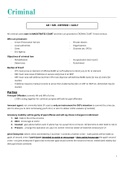Summary
Summary Criminal Law for SQE1 FLK2
- Course
- Institution
notes based on Barbri prep course and external resources - criminal, murder, basic intents, pecific intent, inchoate offense, conspiracy, assault, theft, defenses in notes: D = Defendant W = Witness CPS = Crown Prosecution Service Rmanner = reasonable manner
[Show more]



